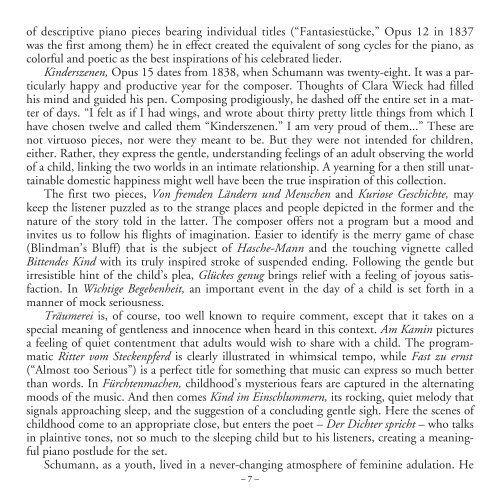Ruth Slenczynskaâ¢SCHUMANN Ruth Slenczynska ... - Ivory Classics
Ruth Slenczynskaâ¢SCHUMANN Ruth Slenczynska ... - Ivory Classics
Ruth Slenczynskaâ¢SCHUMANN Ruth Slenczynska ... - Ivory Classics
You also want an ePaper? Increase the reach of your titles
YUMPU automatically turns print PDFs into web optimized ePapers that Google loves.
of descriptive piano pieces bearing individual titles (“Fantasiestücke,” Opus 12 in 1837<br />
was the first among them) he in effect created the equivalent of song cycles for the piano, as<br />
colorful and poetic as the best inspirations of his celebrated lieder.<br />
Kinderszenen, Opus 15 dates from 1838, when Schumann was twenty-eight. It was a particularly<br />
happy and productive year for the composer. Thoughts of Clara Wieck had filled<br />
his mind and guided his pen. Composing prodigiously, he dashed off the entire set in a matter<br />
of days. “I felt as if I had wings, and wrote about thirty pretty little things from which I<br />
have chosen twelve and called them “Kinderszenen.” I am very proud of them...” These are<br />
not virtuoso pieces, nor were they meant to be. But they were not intended for children,<br />
either. Rather, they express the gentle, understanding feelings of an adult observing the world<br />
of a child, linking the two worlds in an intimate relationship. A yearning for a then still unattainable<br />
domestic happiness might well have been the true inspiration of this collection.<br />
The first two pieces, Von fremden Ländern und Menschen and Kuriose Geschichte, may<br />
keep the listener puzzled as to the strange places and people depicted in the former and the<br />
nature of the story told in the latter. The composer offers not a program but a mood and<br />
invites us to follow his flights of imagination. Easier to identify is the merry game of chase<br />
(Blindman’s Bluff) that is the subject of Hasche-Mann and the touching vignette called<br />
Bittendes Kind with its truly inspired stroke of suspended ending. Following the gentle but<br />
irresistible hint of the child’s plea, Glückes genug brings relief with a feeling of joyous satisfaction.<br />
In Wichtige Begebenheit, an important event in the day of a child is set forth in a<br />
manner of mock seriousness.<br />
Träumerei is, of course, too well known to require comment, except that it takes on a<br />
special meaning of gentleness and innocence when heard in this context. Am Kamin pictures<br />
a feeling of quiet contentment that adults would wish to share with a child. The programmatic<br />
Ritter vom Steckenpferd is clearly illustrated in whimsical tempo, while Fast zu ernst<br />
(“Almost too Serious”) is a perfect title for something that music can express so much better<br />
than words. In Fürchtenmachen, childhood’s mysterious fears are captured in the alternating<br />
moods of the music. And then comes Kind im Einschlummern, its rocking, quiet melody that<br />
signals approaching sleep, and the suggestion of a concluding gentle sigh. Here the scenes of<br />
childhood come to an appropriate close, but enters the poet – Der Dichter spricht – who talks<br />
in plaintive tones, not so much to the sleeping child but to his listeners, creating a meaningful<br />
piano postlude for the set.<br />
Schumann, as a youth, lived in a never-changing atmosphere of feminine adulation. He<br />
– 7 –














